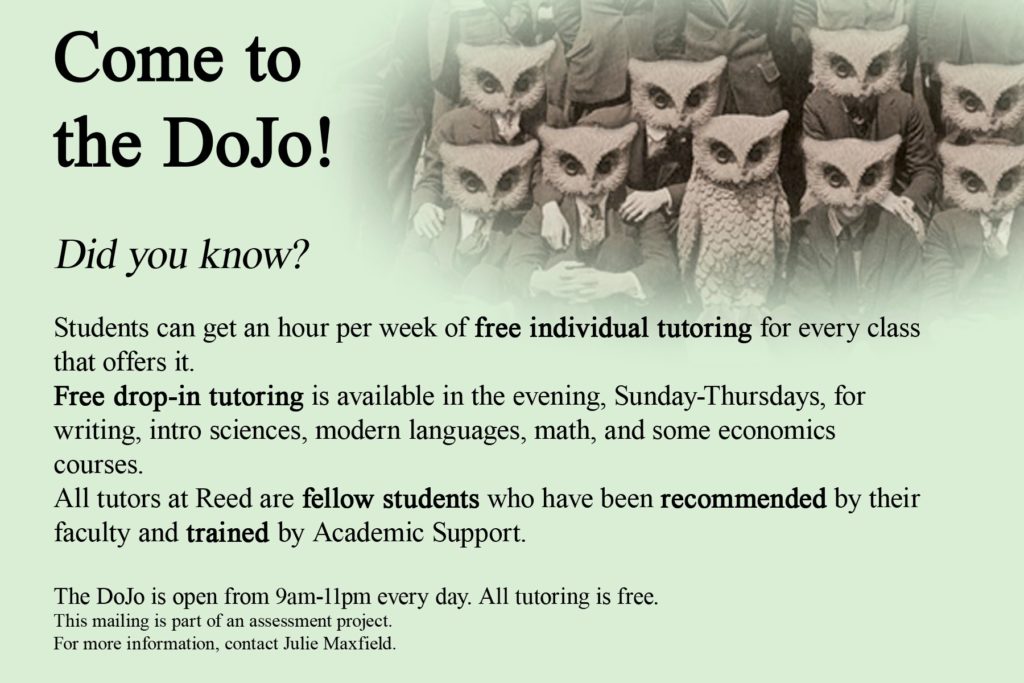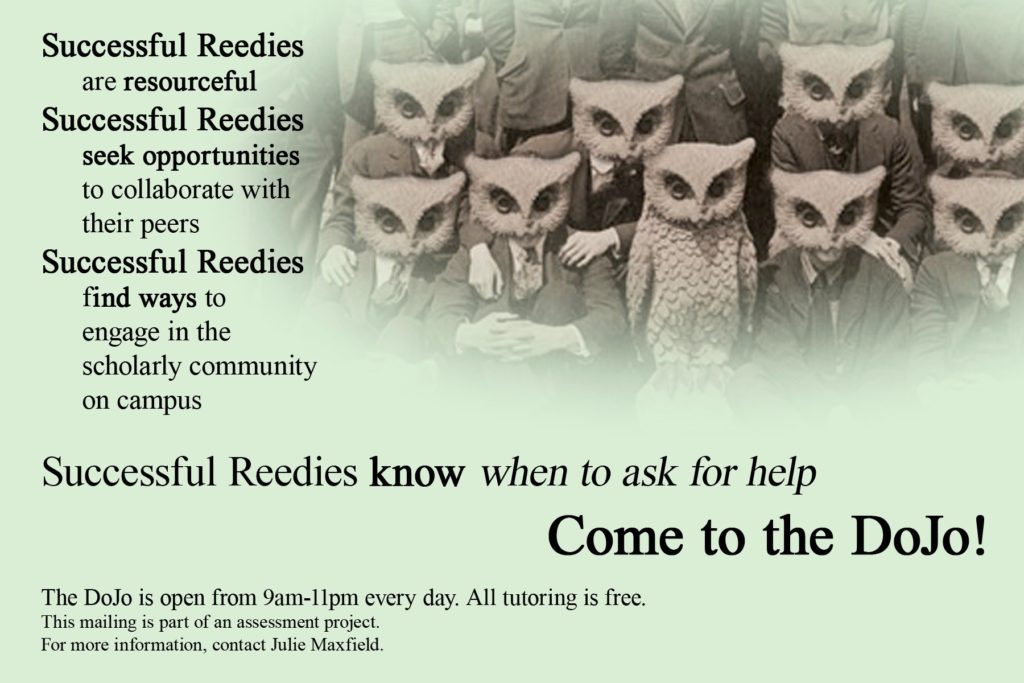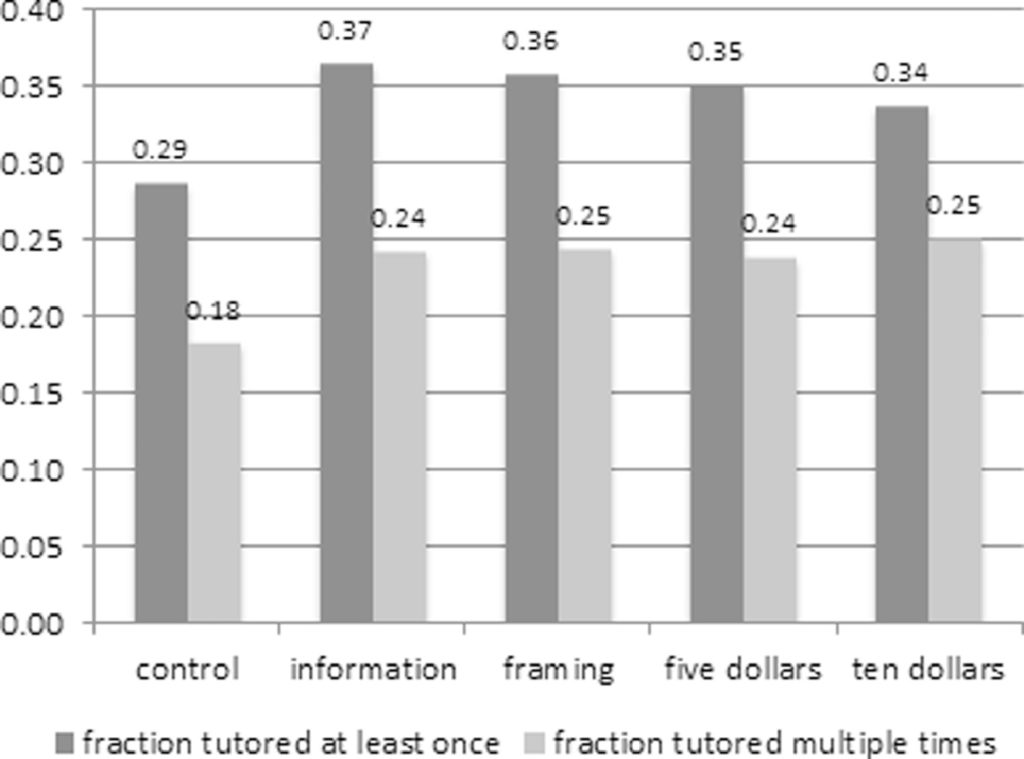
Nudging Study Habits: Peer Tutoring in Higher Education
Organizations : Oregon State University, Reed College
Project Overview
Project Summary
Students at Reed College (United States) were randomly assigned to receive a postcard advertising the availability of free peer tutoring.
Impact
Receiving a postcard increased attendance at peer tutoring sessions by 7 percentage points, from 29% to 36%. Attendance at multiple tutoring sessions increased by 6 percentage points, from 18% to 24%.
Cost
$3.32-$14.58 per additional tutoring hour
Challenge
More than two out of every five students who enrolled in college in 2007 failed to graduate by 2013. Even at selective four-year institutions, more than one-third of students did not graduate in six years. Studying is a fundamental input for student success in college, yet many students study less than necessary to progress to graduation. University students who procrastinate, as measured by self-reported cramming for exams or small delays in course enrollment, have worse academic outcomes. Yet little experimental or quasi-experimental evidence exists on how to change study habits.
Peer tutoring offers one approach to change study habits and improve student outcomes in higher education. This paper evaluates a randomized controlled experiment that advertised peer tutoring services to college students via postcard. The students were all enrolled at Reed College, a liberal arts college with a lower graduation rate than peer institutions.
Design
The intervention, which occurred during the spring semester of 2015, consisted of a postcard placed in the student’s campus mailbox at the beginning of the semester. Postcards varied as follows (images attached):
- Information. Provided information about the tutoring services offered at the center and its opening hours.
- Framing. Information about tutoring, plus the message that “successful” students “know when to ask for help.”
- Incentive ($5). Information about tutoring, plus offered $5 credit at the campus coffee shop if the student attended at least one hour of tutoring.
- Incentive ($10). Same as $5 incentive, but valued at $10.
Each postcard attempted to overcome a different perceived constraint to tutoring attendance. If students were unaware of the tutoring center but would otherwise demand its services, then receiving the information postcard might induce them to attend. Alternately, students already aware of the tutoring center might be induced to attend because the postcard made tutoring more salient in their decisions.
The second postcard framed this information by associating use of the tutoring center with student success. If tutoring carried a negative stigma—a particular concern on a campus of high-achieving students—then this framing should improve tutoring center usage relative to information alone.
The third and fourth postcards paired information with financial incentives. The financial incentive was modest and intended to overcome procrastination, transactions costs, or other small barriers to attending tutoring. If some students were on the margin of choosing tutoring over an alternative activity, the financial incentive might induce them to attend.

Information postcard

Framing postcard

Incentive ($5) postcard

Incentive ($10) postcard
Impact
A randomized evaluation found that a one-time message increased attendance at peer tutoring sessions by 7 percentage points, from 29% to 36%. Attendance at multiple tutoring sessions increased by 6 percentage points, from 18% to 24%.
There were no statistically significant differences in tutoring take-up across different postcard messages. If students were unaware of tutoring before receiving the postcard, then we should expect to see the greatest take-up among first-year students. Yet common take-up across class years helps to rule out a purely informational channel through which tutoring attendance increased. Similarly, common take-up among students who did and did not register for class on the first available day help to rule out reductions in procrastination. Instead, increased salience of tutoring resulting from postcard receipt is consistent with these patterns, though the evidence remains suggestive.

Tutoring take-up by treatment arm
We failed to find any effect of postcard receipt or tutoring attendance on grade point average during the semester of the intervention. This result is consistent with student substitution of study effort between tutored and untutored courses, leaving average grades unchanged. It is also possible that our study was underpowered to detect the relatively small effects on overall grades that might be expected from peer tutoring.
Implementation Guidelines
Inspired to implement this design in your own work? Here are some things to think about before you get started:
- Are the behavioral drivers to the problem you are trying to solve similar to the ones described in the challenge section of this project?
- Is it feasible to adapt the design to address your problem?
- Could there be structural barriers at play that might keep the design from having the desired effect?
- Finally, we encourage you to make sure you monitor, test and take steps to iterate on designs often when either adapting them to a new context or scaling up to make sure they’re effective.
Additionally, consider the following insights from the design’s researchers:
- Postcards were designed in consultation with tutoring center administrators.
- Postcards were mailed to students during the second week of class that semester. We chose the second week of classes to distribute the postcards to ensure salience of their receipt. A disproportionate volume of campus mail is distributed to students during the first week of classes of each semester. Campus mail remains a common form of communication at the college. Conversation with students in classes and in office hours indicates that the vast majority of students report checking their mail box every day.
- In the financial incentives treatments, attendance at any type of tutoring (drop-in, individual, or satellite center) would allow students to redeem the postcard for the given amount at the coffee shop. Postcards were addressed to individual students and tutors checked that the student presenting the incentive postcard to a tutor was its intended recipient, minimizing risk of students sharing incentive postcards across study arms.
Project Credits
Researchers:
Todd Pugatch Oregon State University
Nicholas Wilson Reed College



